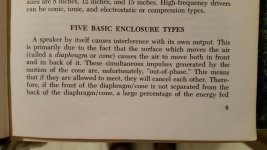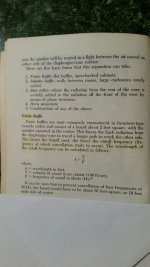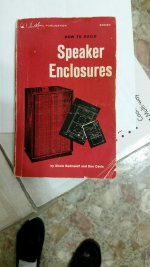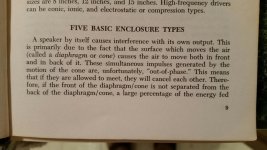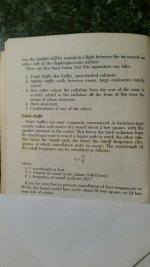Maybe i should reduce a bit my coffee consumption, but hey hey, here's another thread for your DIYolic pleasure, and mine. 😛
So, let's start by the beginning:
http://www.diyaudio.com/forums/multi-way/301988-about-sound-noise-go-through-cone.html
Then, the ''no-box-is-better'' started to show up (as expected), then i tried the 18FH500 baffleless ('cause i couldnt do better tonight) and now i'm asking:
IF the produced bandwith fills my needs (80hz+ as of now)... Is any added baffle is useful/wanted, or the ''baffleless'' or ''minimalistic baffle'' is a approach worth considering ?
I'm simply thinking about reducing as possible the unwanted reflections & resonnances that i felt/heard (that comes usually from an enclosure in the 80-500hz region) and also to reduce the baffle material and size of the ''enclosure''
So, let's start by the beginning:
http://www.diyaudio.com/forums/multi-way/301988-about-sound-noise-go-through-cone.html
Then, the ''no-box-is-better'' started to show up (as expected), then i tried the 18FH500 baffleless ('cause i couldnt do better tonight) and now i'm asking:
IF the produced bandwith fills my needs (80hz+ as of now)... Is any added baffle is useful/wanted, or the ''baffleless'' or ''minimalistic baffle'' is a approach worth considering ?
I'm simply thinking about reducing as possible the unwanted reflections & resonnances that i felt/heard (that comes usually from an enclosure in the 80-500hz region) and also to reduce the baffle material and size of the ''enclosure''
Few Baffless pictures found on Google:
An externally hosted image should be here but it was not working when we last tested it.
An externally hosted image should be here but it was not working when we last tested it.
An externally hosted image should be here but it was not working when we last tested it.
OB is a well known and well documented principle. Please do a minimum of research before running all over the boards like a moon crazed buffalo.
except for the occasional moon-crazed buffalo on the loose, there's been so little interest in OB on this forum lately. too bad, unbaffled dipoles are very cool. here's my 2 cents:
for the mid, a small square-ish baffle the same size of the driver frame is something to consider. you get a slightly smoother freq. response from the differing path lengths (at the expense of a slight degradation of the dipolar pattern) and a little more support for the low end. also it could make hanging/mounting easier and/or more visually appealing.
check out the LX521, the baffle shape around the 8" was probably arrived at with the above in mind, although "visually appealing" is of course a slippery concept.
get the Tolvan Edge program and you can play around with the baffle shape and see the response.
Tolvan Data
for a mid-bass driver that will be crossed well before it's "nude" dipole peak, a larger baffle might be used without disrupting the polar response too much. in this case you may want to suspend the driver behind a baffle, really close but not touching. you'll get the acoustic baffle support without the unwanted energy storage. this arrangement could be tricky to engineer though.
if you did something like the DIY picture you posted with the wooden frame, you could hang the woofers with one driver reversed. it would hang in better balance and the asymmetrical front/rear response would become balanced as well.
for the mid, a small square-ish baffle the same size of the driver frame is something to consider. you get a slightly smoother freq. response from the differing path lengths (at the expense of a slight degradation of the dipolar pattern) and a little more support for the low end. also it could make hanging/mounting easier and/or more visually appealing.
check out the LX521, the baffle shape around the 8" was probably arrived at with the above in mind, although "visually appealing" is of course a slippery concept.
get the Tolvan Edge program and you can play around with the baffle shape and see the response.
Tolvan Data
for a mid-bass driver that will be crossed well before it's "nude" dipole peak, a larger baffle might be used without disrupting the polar response too much. in this case you may want to suspend the driver behind a baffle, really close but not touching. you'll get the acoustic baffle support without the unwanted energy storage. this arrangement could be tricky to engineer though.
if you did something like the DIY picture you posted with the wooden frame, you could hang the woofers with one driver reversed. it would hang in better balance and the asymmetrical front/rear response would become balanced as well.
Maybe i should reduce a bit my coffee consumption, but hey hey, here's another thread for your DIYolic pleasure, and mine. 😛
So, let's start by the beginning:
http://www.diyaudio.com/forums/multi-way/301988-about-sound-noise-go-through-cone.html
Then, the ''no-box-is-better'' started to show up (as expected), then i tried the 18FH500 baffleless ('cause i couldnt do better tonight) and now i'm asking:
IF the produced bandwith fills my needs (80hz+ as of now)... Is any added baffle is useful/wanted, or the ''baffleless'' or ''minimalistic baffle'' is a approach worth considering ?
I'm simply thinking about reducing as possible the unwanted reflections & resonnances that i felt/heard (that comes usually from an enclosure in the 80-500hz region) and also to reduce the baffle material and size of the ''enclosure''
Read this, it will give you some insight into Dipole theory.
You may need to copy this link to Google to download it.
C.M
Last edited:
This one could help about the OB Bass : Subwoofer Origami
Hello Eldam,
I won't even bother trying to make a dipole/OB subwoofer, as i already have the solution (sealed box) that works very well even in the infrabass.
Fighting the acoustic short-circuit is not something i'd like to do, as of now i see the 18FH500 is good from 80hz in a dipole config, which is excellent for my needs.
Read this, it will give you some insight into Dipole theory.
You may need to copy this link to Google to download it.
C.M
Thank you C.M., that's a very thorough document indeed. 🙂
except for the occasional moon-crazed buffalo on the loose, there's been so little interest in OB on this forum lately. too bad, unbaffled dipoles are very cool. here's my 2 cents:
for the mid, a small square-ish baffle the same size of the driver frame is something to consider. you get a slightly smoother freq. response from the differing path lengths (at the expense of a slight degradation of the dipolar pattern) and a little more support for the low end. also it could make hanging/mounting easier and/or more visually appealing.
check out the LX521, the baffle shape around the 8" was probably arrived at with the above in mind, although "visually appealing" is of course a slippery concept.
get the Tolvan Edge program and you can play around with the baffle shape and see the response.
Tolvan Data
for a mid-bass driver that will be crossed well before it's "nude" dipole peak, a larger baffle might be used without disrupting the polar response too much. in this case you may want to suspend the driver behind a baffle, really close but not touching. you'll get the acoustic baffle support without the unwanted energy storage. this arrangement could be tricky to engineer though.
if you did something like the DIY picture you posted with the wooden frame, you could hang the woofers with one driver reversed. it would hang in better balance and the asymmetrical front/rear response would become balanced as well.
Hi Tommus,
Actually i was thinking of a laser-cut steel ''baffle'' which won't really be a baffle because i will make the design like a grill, with many holes, so it should act as a dipole. Basically, i'll design it so it's a solid and visually appealing structure, but as ''transparent'' as possible.
I like what i hear at the moment with the 18FH500 (compared to the sealed box test i just made before) and i don't want to lose that ''boxless'' type of sound feeling.
JOn I would suggest you explore dipole bass, lots of advantages. Try a MJK H frame woofer with Eminence Alpha or Beta 15a for a start.
Maybe i should reduce a bit my coffee consumption, but hey hey, here's another thread for your DIYolic pleasure, and mine. 😛
An externally hosted image should be here but it was not working when we last tested it.
No, i had to reduce some coffee.i am in favor of baffle-less
back to basics
The range 80-500 is the most difficult to address. It will almost always impart a sonic signature, depending upon your solution. Eliminating the baffle is not really a solution.
Maybe i should reduce a bit my coffee consumption, but hey hey, here's another thread for your DIYolic pleasure, and mine. 😛
So, let's start by the beginning:
http://www.diyaudio.com/forums/multi-way/301988-about-sound-noise-go-through-cone.html
Then, the ''no-box-is-better'' started to show up (as expected), then i tried the 18FH500 baffleless ('cause i couldnt do better tonight) and now i'm asking:
IF the produced bandwith fills my needs (80hz+ as of now)... Is any added baffle is useful/wanted, or the ''baffleless'' or ''minimalistic baffle'' is a approach worth considering ?
I'm simply thinking about reducing as possible the unwanted reflections & resonnances that i felt/heard (that comes usually from an enclosure in the 80-500hz region) and also to reduce the baffle material and size of the ''enclosure''
The range 80-500 is the most difficult to address. It will almost always impart a sonic signature, depending upon your solution. Eliminating the baffle is not really a solution.
Attachments
Small, narrow, baffle-less, should be a consideration for constant directivity higher in the frequency range
What? I thought they were the all the rage here, lately.except for the occasional moon-crazed buffalo on the loose, there's been so little interest in OB on this forum lately.
The range 80-500 is the most difficult to address. It will almost always impart a sonic signature, depending upon your solution. Eliminating the baffle is not really a solution.
I have a difficult time understanding what you are trying to say with your text and images from some text about loudspeakers.
I don't agree with your assertion that 'eliminating the baffle is not really a solution'. Regarding the OP's concern about re-radiation of the driver's backwave out throught the cone in a boxed loudspeaker, an OB or nude mounting of the driver would seem to completely eliminate that.
Now what is stated on your "page 9" image is true - in an OB or nude system the backwave and frontwave interfere at low frequencies and this causes a loss of sound pressure that at low enough frequencies is problematic. But there are plenty of ways to design around this fact. For example, a 12" driver in a modest OB with some EQ can still reach 80-100Hz at SPLs that are quite sufficient for listening in the home environment, that is unless you love really big, loud horn systems. But that's a totally different animal and has lots of flaws itself.
Careful choice of driver size, driver efficiency, cone excursion capability, baffle size and power requirements plus measurement-based design of EQ for the system will produce very good results in an OB system. Using a small t-line (aka U-, M- frame, etc.) can allow reasonable sized dipole bass systems (see Linkwitz LX521 for example) that can operate up to 100Hz, where the OB's "woofer" is starting to run out of displacement capability.
I have a difficult time understanding what you are trying to say with your text and images from some text about loudspeakers.
I don't agree with your assertion that 'eliminating the baffle is not really a solution'. Regarding the OP's concern about re-radiation of the driver's backwave out throught the cone in a boxed loudspeaker, an OB or nude mounting of the driver would seem to completely eliminate that.
Now what is stated on your "page 9" image is true - in an OB or nude system the backwave and frontwave interfere at low frequencies and this causes a loss of sound pressure that at low enough frequencies is problematic. But there are plenty of ways to design around this fact. For example, a 12" driver in a modest OB with some EQ can still reach 80-100Hz at SPLs that are quite sufficient for listening in the home environment, that is unless you love really big, loud horn systems. But that's a totally different animal and has lots of flaws itself.
Careful choice of driver size, driver efficiency, cone excursion capability, baffle size and power requirements plus measurement-based design of EQ for the system will produce very good results in an OB system. Using a small t-line (aka U-, M- frame, etc.) can allow reasonable sized dipole bass systems (see Linkwitz LX521 for example) that can operate up to 100Hz, where the OB's "woofer" is starting to run out of displacement capability.
What I am trying to say is, with the open baffle concept, one is creating a battle which will result in mediocre results, at best, with regards to bass response. Totally eliminating any kind of baffle at all, is preposterous.
Also, it does not matter much to me, if you disagree. Physics still rule the day.
By rights, I should have included the source of the text.
Attachments
@ Scott and Charlie
I fully understand about the limitations of the ''bass'' results from OBs, but ''bass'' is very vague.
Let's say 80hz or 100hz is a no-no with OBs (or at least naked, baffleless) but what about 1 octave higher ? (160hz) or 1.5 octave higher (240hz) or so ?
Is there a point where we can say ''Yes, ABC driver can work properly baffleless from xxxHz and up''
Let's create a rule of thumb where (2xFs)/(2xQts) = the minimum highpass crossover point for baffleless.
(i'm kidding, don't do that.. )
I fully understand about the limitations of the ''bass'' results from OBs, but ''bass'' is very vague.
Let's say 80hz or 100hz is a no-no with OBs (or at least naked, baffleless) but what about 1 octave higher ? (160hz) or 1.5 octave higher (240hz) or so ?
Is there a point where we can say ''Yes, ABC driver can work properly baffleless from xxxHz and up''
Let's create a rule of thumb where (2xFs)/(2xQts) = the minimum highpass crossover point for baffleless.
(i'm kidding, don't do that.. )

An externally hosted image should be here but it was not working when we last tested it.
An externally hosted image should be here but it was not working when we last tested it.
An externally hosted image should be here but it was not working when we last tested it.
Even with a 12" if no very widthy bafle, you will need a lot of Boost with 160 HZ F3 in OB ! Read the AinoGradient thread !
I agree with ScottL than the area talked is a complicate one to reproduce !
For instance in a simple Sealed or even vented cabinet benchmark a good PA 8" driver with a good aerogel from Audax ! It's night & Day (Aerogel winns) ! Te trade offs are particulary difficult in this area with global tonal balance !
It's tonal balance vs punchy slam etc ! Have a too big driver, even the voice will be not so natural ! 6" to 8" seems to work above 150 Hz !
At least my speaker is a sealed 5" aluminium 125 Hz to 2000 HZ electrical and 2600 acoustical. Voices are splendid but I come to think one need different designs according what your are listening to (Rock, classic....)
One need the precision of an ESL with the slam & dynamic of a fronted horn ! Difficult ! And rooms are very involved here also ! Even difficult to talk between us because of that !
I agree with ScottL than the area talked is a complicate one to reproduce !
For instance in a simple Sealed or even vented cabinet benchmark a good PA 8" driver with a good aerogel from Audax ! It's night & Day (Aerogel winns) ! Te trade offs are particulary difficult in this area with global tonal balance !
It's tonal balance vs punchy slam etc ! Have a too big driver, even the voice will be not so natural ! 6" to 8" seems to work above 150 Hz !
At least my speaker is a sealed 5" aluminium 125 Hz to 2000 HZ electrical and 2600 acoustical. Voices are splendid but I come to think one need different designs according what your are listening to (Rock, classic....)
One need the precision of an ESL with the slam & dynamic of a fronted horn ! Difficult ! And rooms are very involved here also ! Even difficult to talk between us because of that !
Last edited:
- Home
- Loudspeakers
- Multi-Way
- Open Baffle OR Baffle-less ?
